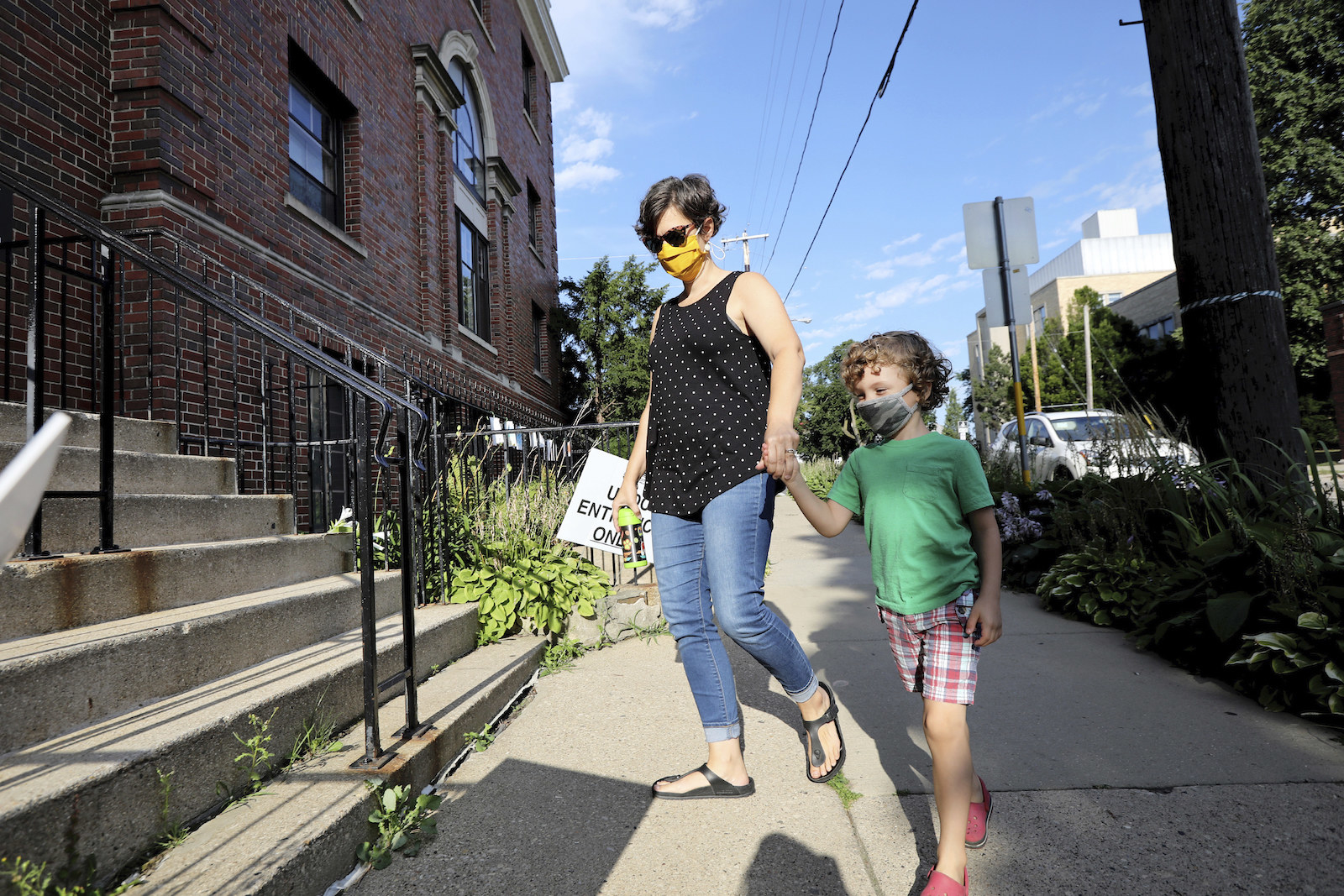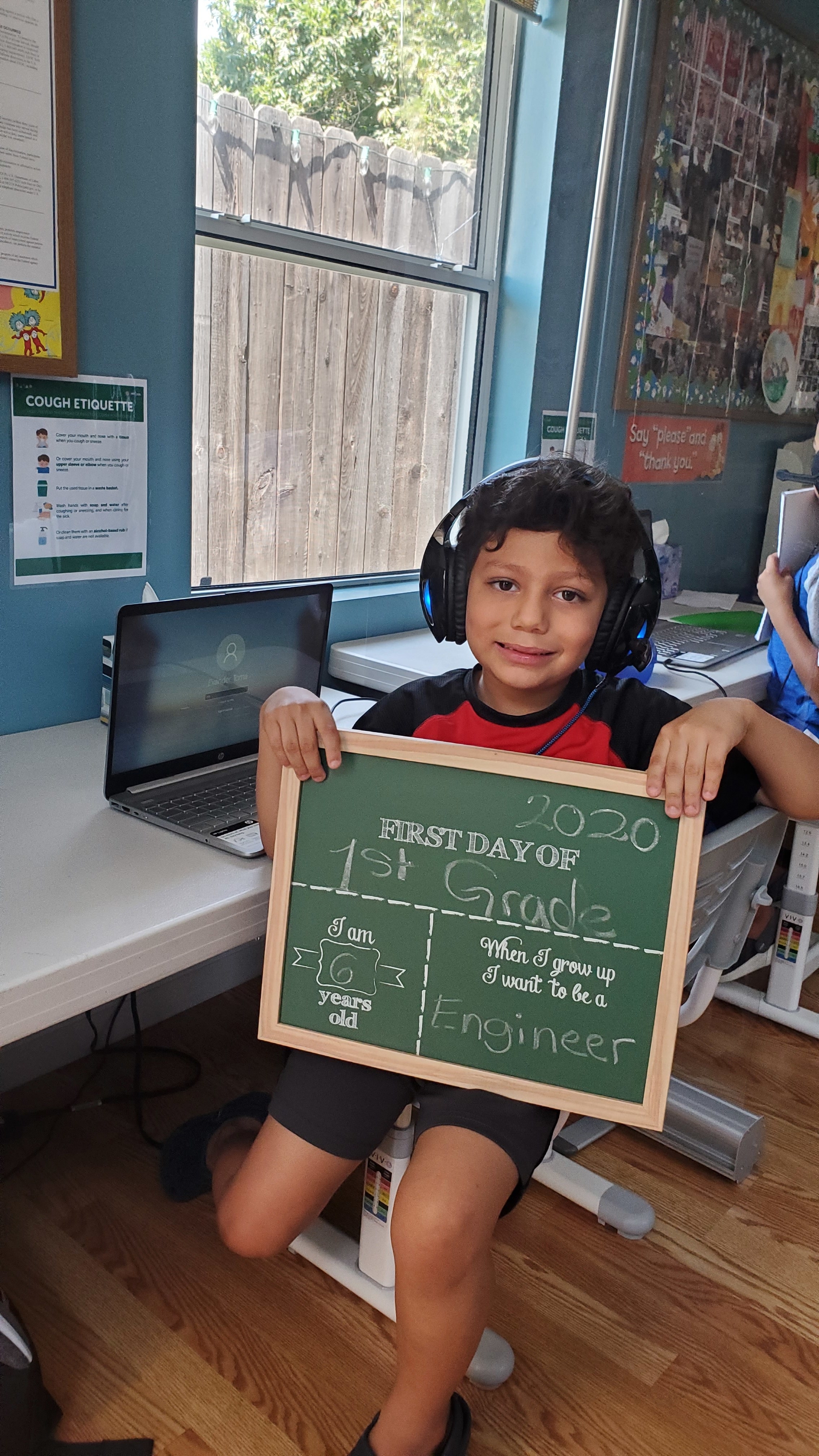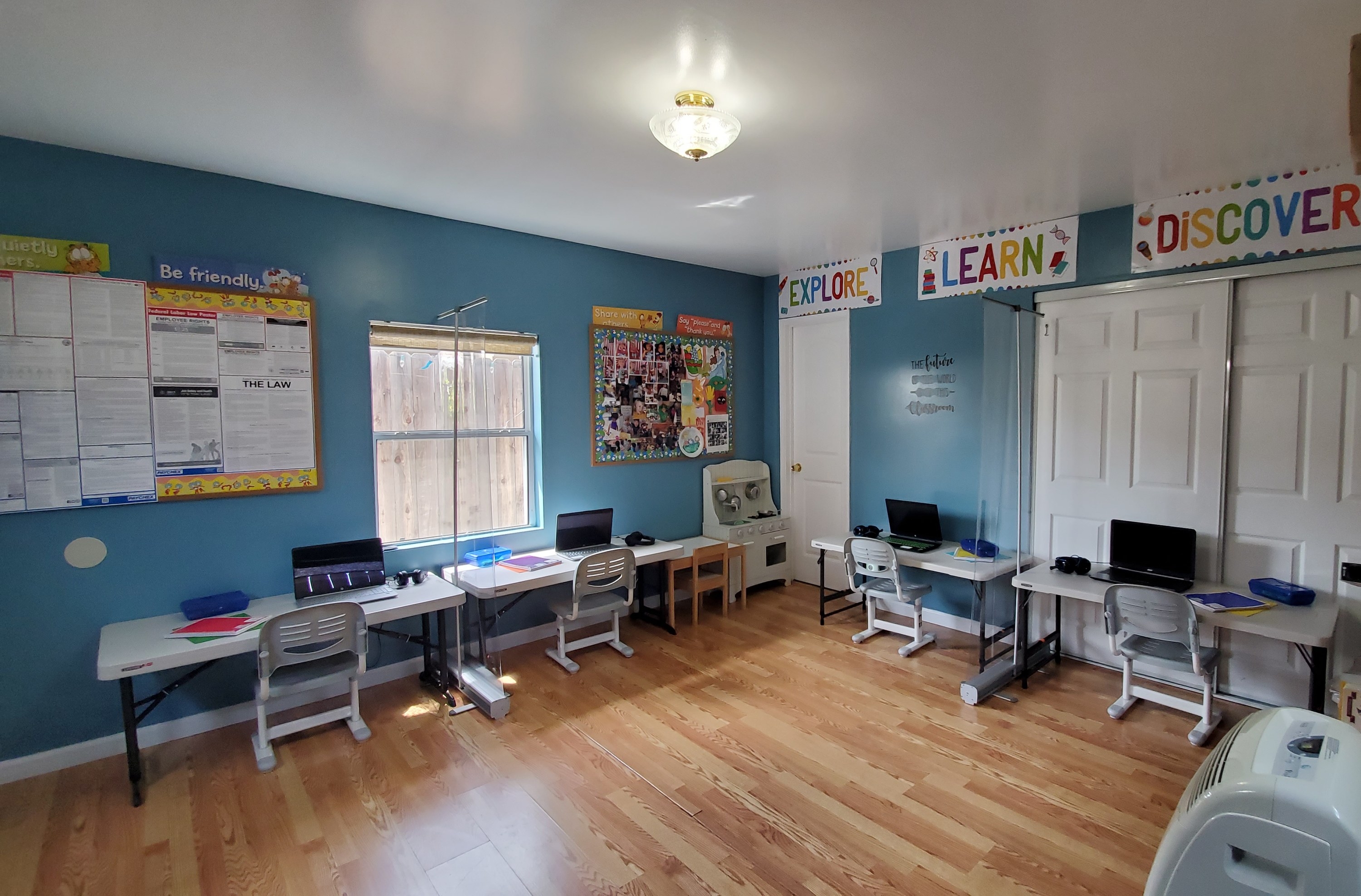
Each morning at 4 a.m., hours before the sun rises, Monica gets out of bed and begins her day. First, she tends to her 1-year-old baby, before preparing coffee and breakfast. Then she and her child drive 10 miles north to a big, open house set on 40 acres in rural Alaska, where from 9 a.m. until 2 p.m., she watches over four children, plus her own son, as a private nanny.
Monica never expected to be a nanny. She was expecting to be a stay-at-home mom to her new baby. Then, her husband was laid off in March as the pandemic shut down the economy. Weeks went by without any income, as delays at the labor department held up unemployment benefits. But the Alaska air was still cold, and a $300 heating bill needed to be paid.
Her husband found work again in May, and in June, she found a job caring for the children of a nearby family for $14 an hour. That’s more than the state’s $10.19 minimum wage, but still not enough to afford childcare for her own baby, about $1,200 a month, if she and her husband were out working. The hiring family said she could bring her infant, who had been born 6 weeks prematurely, to work with her. So she agreed. And this is how she has kept her household afloat since COVID-19 turned everything upside down: caring for four children who aren’t hers — and one that is — for $14 an hour, 20 hours a week.
“It's strange being on the other side of it, thinking that last year that we might need [childcare] and now I'm providing it,” she said.
The entire industry of childcare, as well as those who work in it, is facing a crisis. The fundamental issue is that while childcare is a huge expense for families, it still doesn’t cost enough to pay most workers in the field a wage that allows them to support their own children. Many daycare centers are facing financial ruin, with thousands already closed, as parents keep their children home out for fear for their safety.
“If childcare doesn’t work, the rest of the country doesn’t work. There’s a spotlight being shined on childcare now, but if it doesn’t lead to structural changes, it’s all for naught,” said Rhian Allvin, CEO of the National Association for the Education of Young Children.
Around the country, child caregivers overcame fears about exposing themselves and their families to the virus to earn a living, often from families that earn far more than they do. The median pay in this field is $24,000 a year, according to the US Bureau of Labor Statistics (BLS). And this does not include the large number of workers who do the job off the books — with no benefits and often at lower wages. The average annual cost of infant care: $9,600 for family care, which is often home-based, and $15,000 for center-based care. This poses a huge dilemma for childcare workers who have children of their own.
If childcare doesn’t work, the rest of the country doesn’t work.
“The only way that it's sustainable for me is I can bring him with me. If I were to go out and work in other people's homes and have to put him in daycare, there's no way that I would be able to swing that. I would be making [just a few] dollars after paying for his own childcare,” said Monica, who asked that her last name not be used.
All parents must grapple with the reality that working isn’t always financially viable if you also need childcare — families with children under age 5 spend about 10% of their income on average on childcare, according to the Center for American Progress, and that percentage gets higher — as high as 35% for the poorest families — as income gets lower. Childcare, like housing, faces a serious affordability crisis.
This reality is especially painful and frustrating for parents who themselves work in childcare, and find themselves caught between two crushing forces for American families: low wages and the high cost of care. Some parents say it is not a sustainable job if you must support a family, even if you are able to take your children with you. The pay is too low, the days are too long, and the risk of burnout is real.
While she feels grateful to have found work and likes the family she is working for, “I wish that childcare was taken more seriously because I do feel like it's an essential service, and it's not treated as such — it never has been. We can't have people working and contributing to society if they can't find someone to take care of their kids while they do that,” said Monica. “And daycare centers can't pay their employees if they're not charging a certain amount. It's a huge mess.”
While BLS expects parents who work will continue to need the assistance of childcare workers, “the increasing cost of childcare may reduce demand for childcare workers.” Now, as enrollment in childcare programs cratered during the pandemic, fewer than 1 in 5 programs expect to survive longer than a year, according to a survey by the NAEYC.
Even before the crisis, compensation has been a deep concern in the field, with nearly half of early childhood educators eligible to receive some form of government assistance, said NAEYC’s Rhian Allvin. Despite research showing how important these early years are, “most early childhood educators are underpaid, based on the value they’re contributing to society, as a profession. Without more systemic support from the government and employers, the impasse remains: “Parents can’t pay any more and childcare workers can’t make any less.” And for parents who work in childcare, like other essential workers who cannot work from home, “there’s an added conundrum in terms of where their children spend the day,” Allvin said.

For those who could afford it, the need for emergency childcare became urgent after COVID-19 shut down schools. Monica started getting emails — several emails every hour — through her old Care.com profile from parents who suddenly, urgently needed childcare. Soon, she was getting emails, texts, and voice messages throughout the day. Parents were asking her to start immediately, without even an interview, and offering cash if she could arrive in an hour.
“To go to another family's home, not only being exposed to them during a pandemic, but also not knowing what their expectations or biases or opinions were about it — it was nerve-wracking,” she said. “I ended up going on 15 interviews because I needed to make sure I was going to be able to help them with what they needed and that I was going to be able to bring my son with me safely.”
Eventually, a mother emailed her. It wasn’t the frenzied, desperate inquiry she was used to, but a request for advice on finding a good nanny. Her husband was an essential worker, and she had been trying to work from home with their four children, which was an untenable arrangement. They introduced themselves by phone, hit it off, and two hours later, Monica had a new job.
Other working families in the area were scrambling to find care. Monica’s friends from college who had just lost jobs in banking and marketing were finding lifelines as nannies.
“You see it with nurses, people working at grocery stores and gas stations, these services that we didn't even bat an eyelash at before, who are now in the spotlight because, hey, we're doing a huge job,” Monica said. “People that work in childcare centers, teachers, private nannies, and babysitters, all of a sudden, oh, you guys are essential.”
These workers, and the families they work for, have been holding it together over the last six months, but they still need help. “I'm hoping that childcare and childcare assistance becomes a priority. It shouldn't be a luxury,” Monica said.
The journalists at BuzzFeed News are proud to bring you trustworthy and relevant reporting about the coronavirus. To help keep this news free, become a member and sign up for our newsletter, Incoming.
In Sacramento County, California, Alani, who asked her last name not be used, watched the battle unfold between teachers and the state about reopening classrooms through the summer. Protect the children! Protect the teachers! She wondered why early childhood educators like herself, who continued to come in throughout the pandemic to care for the children of other essential workers, never drew that level of concern or sympathy — from lawmakers, from parents, or from the public in general.
For months, she had been coming to work at a childcare center, bringing along her 7-year-old daughter, to keep the community running as the coronavirus ravaged the country. And she was earning $15 an hour for it.
It’s hard for her not to feel resentful. “It just seems like we're being overlooked,” she said. “When I read what K–12 teachers are saying, me, having worked at a designated essential center while the rest of the world shut down, I’m doing exactly what K–12 are reluctant to do. Today, I was in a classroom with 24 kids and a co-teacher.”
What keeps her going in, with her daughter, is an extreme commitment to the work. “I feel like if I didn't go back, I'd be abandoning those kids. I'd be abandoning my passions. I'd be abandoning those families,” she said. “Not every household is safe for children to be in every day. And not every family has responsible adults who can meet the intense demands of distance learning. We know this.”

Yet at her current salary, Alani can’t afford to send her daughter to her own center at full tuition. In the end, she said, “We make basically nothing.” And her passion for the work doesn’t obscure the fact that it is hard.
At 5 a.m. Alani awakes in the two-story townhouse she rents with her husband and child. There’s time for a quick workout before her daughter wakes up. They get ready to leave the house together around sunrise so she can start the day at the daycare center at 7 a.m. Since schools shut down, she’s had no choice but to bring her child along with her, as her husband, also deemed an essential worker, must leave the house to do his job as a mechanic. The 7 a.m. shift is still early, but discernibly more relaxed than the opening schedule she recently had, which required her to be out the door with her daughter by 5:45 a.m.
Bringing her daughter along with her to work came at a price too; the center offers employees a discounted rate, which had been free thanks to California childcare subsidies for essential workers that ran until Sept 1. Now, Alani pays a discounted rate of $105 per week, which is still a sizable chunk of her paycheck.
“Parent-me and teacher-me, they kind of clash,” Alani said. Parents need affordable childcare; teachers need a safe work environment and livable wages. “I see it from two from both sides. They're both just so conflicting.”
When things shut down in the spring, enrollment at Alani’s center fell to less than 50 kids from 200, mostly kids of healthcare workers, first responders, grocery employees, and other essential workers who, like her, had no choice but to go in. “Everybody was scared. So were we, but we were still there,” she said. Her classroom shrank to six kids from 24.
“[K–12] teachers don’t feel safe returning to work, but, you know, it's always on our minds too. Is it safe for us to be here?” she said. “My center, we've been great. But there's always that fear. Especially because we were caring for essential families. But my job wasn't giving me the option to opt out. I have a family and I can’t not have an income.”
"Everybody was scared. So were we, but we were still there."
The center implemented safety protocols: taking temperatures at the door, cleaning around the clock, even sanitizing pens after they’ve been touched. “We're absolutely doing the best that we can.” Now, when she hears the debates about whether schools should reopen, “I get really frustrated, because here I am.”
According to NAEYC’s Allvin, surveys show that early childhood educators are held in high esteem by voters, but those who work in the industry don’t feel like they are, mainly due to their compensation. “There’s a mismatch between what people think about early childhood educators and how they believe they’re valued. The pandemic exacerbated that,” Allvin said.
Better wages, Alani said, are the only thing she can think of that would help temper her inner conflict. “That would make all the internal struggle really worth it right now,” she said. “As much as watching the kids grow and giving back to my community is great, there should be a little something more. There's got to be a little more of a benefit for me and my family.”
In mid-September, she decided to leave the industry.
About 400 miles south of Alani, in Los Angeles’ Signal Hill, Zoila Toma opens the doors to her home from 6 a.m. to 6 p.m. She runs from her daycare from her residence, where she lives with her husband and three children, ages 17, 8, and 6.
It’s a later start than she had gotten used to before the pandemic, when she would rise just after 5 a.m. to get her house ready for the children. Parents are now bringing their kids in a little later, giving her a little more private time in the mornings, and they’re picking them up earlier too.
Before COVID-19, Toma would watch some kids as late as 10 p.m. At that point, long after many parents had put their children to bed, she’d start cleaning her house, to start the next day fresh. “This is an industry where you could work 14 hours every day,” she said. “Maybe Saturday I could be a little lazy because I don’t have any kids coming on Sunday, so I don’t have to worry about where I left my things — in my own house. But come Sunday night, I had to make sure there’s nothing out of place, and the house is safe for all the kids.”

Of course, that was then. Back in February, her Castle in the Sky Daycare had 18 children signed up for services from morning drop-off to full-time care. Now, some days there are six children, some days eight; some days Toma doesn’t work. As they enter her home, they must wash their hands; she sprays the bottom of their shoes with alcohol.
Childcare programs around the country are facing similar crises. Average enrollment at programs is down by about two-thirds nationwide — the average number of children at centers decreased to 48 from 105, and to 7 from 12 at family homes, according to NAEYC’s survey. Already, thousands of childcare centers have closed around the country as parents withdrew their children to keep them safe from the risk of the coronavirus. Whenever the economy reopens and parents are expected to return to their workplaces, it is not clear in many places who will take care of their kids.
For a full day of watching a child, Toma charges $275 per week for an infant, $205 for toddlers, and $168 for school-age children. Some families paid privately, others with a childcare subsidy for low-income households. Some of the parents have white-collar jobs — professors, accountants — while others work in the food industry. In a normal year, her 14-hour days meant she could pay herself about $40,000 after expenses. In 2020, the bulk of her pay will come from a Small Business Administration loan she took out. “The reality is if this continues, these loans are not gonna be there next year,” she said.

Toma started the business in 2011, when her oldest child was 8 years old and she was pregnant with her second. It allowed her to care for her children and also earn a living. “I don't think anybody wants to sound like they're complaining. We're doing a very fulfilling job, but the only reason that it worked for me is, like, because I am not paying for daycare myself. I am caring for my children.”
The pandemic is forcing her to work with her children on remote learning now and pivot her business to serve other school-age children who are unable to attend classes from home as her regular daycare numbers were too low to be viable.
The transformation required new, $50 chairs for older kids, $5,000 for laptops, earphones to help the kids focus on their own classes and tune out those streaming from the other kids’ screens, $300 worth of sneeze guards, PPE for staff and the kids, and a store of cleaning supplies — altogether $15,000 so far, which she is paying for with an SBA loan.
She’s had to bring on new staff who are proficient with technology to help juggle the remote classes, which are all happening on different schedules with different breaks for lunch. Meanwhile, the daycare’s expenses — $500 for electricity, mostly for air-conditioning in the summer, insurance, water, lawyer fees — haven’t stopped.
By early September, Toma had nine children enrolled, and a few more families planned to sign up as school classes were kicking off again.
“This business is very nice and fulfilling, but I eventually want to close it,” she said. “Your privacy is compromised. You have people coming in and out of your house, at any given time of the day. This is the industry.”
In Alaska, Monica spends much of the day at her employer’s property. The house already has twice as many bedrooms as Monica’s (including the room she rents out to a friend). Their pantry is always full, she’s noticed, with an abundance of options, including luxury items like expensive chia seeds. “Sometimes something goes on in my mind, like, Could we do this eventually? What would we have to do to be able to have things that aren't … necessities?” she said. Monica’s family is never hungry, but being on a budget means being sensitive to price changes and scarcity at the grocery store caused by panic buying.
The job doesn’t afford much time to dwell though: Lunches have to be made, and the children are anxious to get to the park.●

Correction: Toma received a Small Business Administration loan. An earlier version of this post misstated the origin of the loan.
